The Weather from the Sun
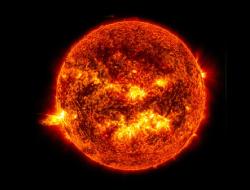 Our Sun is essential for life in our Solar System. However it can also present a serious problem. Science Fiction creators have long explored the possibility that the Sun could cause an extinction-level event, wiping out (a substantial fraction or all of) humanity. However science fiction has also explored the potential impacts of the Sun’s less extreme and more routine variability and its effects in Earth’s orbit - a group of phenomena collectively known as space weather.
Our Sun is essential for life in our Solar System. However it can also present a serious problem. Science Fiction creators have long explored the possibility that the Sun could cause an extinction-level event, wiping out (a substantial fraction or all of) humanity. However science fiction has also explored the potential impacts of the Sun’s less extreme and more routine variability and its effects in Earth’s orbit - a group of phenomena collectively known as space weather.
Surfing the Solar Wind
The term solar wind describes the constant stream of radiation and particles emitted by the Sun which sweeps past Earth. In its mildest form, this might just be comprised of low frequency photons – particles of light - and is used analogously to an Earth-bound wind in science fiction: as a source of energy and propulsion when captured by solar-sailed vehicles. This premise is widespread in science fiction, appearing in examples including Survey Ship (novel, Bradley,1980) and “Sunjammer” (aka “The Wind from the Sun”, short story, Clarke, 1964) and even fitted to rocket ship Thunderbird Three in the recent animated series Thunderbirds are Go (episode “Night And Day”, 2018). However the solar wind is not necessarily a benign and gentle breeze.
On the planet’s surface, we are largely protected from the solar wind by the Earth’s magnetic field, which acts as a giant wind-break, diverting the stream to either side and into belts of radiation held high above the surface. This both prevents harmful radiations from damaging life on the surface of Earth and avoids the erosion of our atmosphere (which itself absorbs much of the residual radiation). However the protection of the magnetosphere is not perfect. Some highly energetic particles break through and are funnelled down to the Earth’s magnetic poles – these release energy to ionize the atmosphere, leading to the phenomenon of aurorae [1]. These vary in intensity day to day as the solar wind fluctuates, and also from year to year as the Sun’s emissions follow an eleven-year cycle from solar maximum to solar minimum. At times they put on a particularly impressive display, powered by a huge storm-front in the solar wind, a phenomenon known as a Coronal Mass Ejection (CME) which causes a rapid outflow from the Sun for a short period, sending a jet of radiation in a near-random direction.
Inevitably, science fiction has taken the idea of solar variability to extremes, with flares from the Sun leading to extinction-level events in examples as varied as Larry Niven’s “Inconstant Moon” (short story, 1971), Ian Watson’s “Nightmares” (short story, 1981), Clarke and Baxter’s “Sunstorm” (novel, 2005), Doctor Who episode “Forest of the Night” (TV episode, 2014), and the extraordinarily bad "End of the World" (film, 2018) amongst many other catastrophes. However the solar wind is also the driver and energy source for much milder and more normal space weather – storms, winds and calm periods which track how the Sun is affecting our planet and its environs as part of its regular cycle. While this variability is usually discussed in the context of the Sun and Earth, aurorae have been seen on several other solar system bodies, and any planet-hosting star is likely to show some variations in the space weather it supports. For locations outside of Earth’s protective atmosphere and magnetosphere, even these routine solar storms can be dangerous events, with both crew and technology vulnerable to damage. As a result, forecasting the solar wind is an ever more pressing problem.
Radiation Hazard
The most immediately dramatic threat caused by space weather is the danger to human life that is associated with exposure to hard ionizing radiation. In severe cases, this can cause radiation sickness and ultimately death. However even less severe storms are associated with an increased risk of damage to DNA and the subsequent development of cancers, above the already high threshold experienced in space. As a result, the occupants of the International Space Station live in quarters with added shielding, to which they are ordered to retreat in the event of a strong geomagnetic storm. The astronauts of the Apollo era in the 1960s faced a still higher risk, travelling beyond most of the Earth’s magnetic protection, and a major solar storm actually occurred in the interval between two missions – fortunately so, as if it had occurred a little earlier or later the radiation exposure could have been lethal.
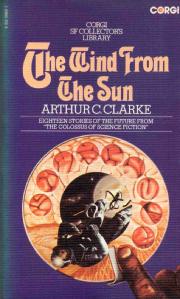 Such risks have long been recognised. The solar-sail racing in Arthur C Clarke’s “Sunjammer” can only take place during quiet years of the solar cycle, and the race at the story’s focus is abandoned due to the threat presented by a solar flare. As he explains:
Such risks have long been recognised. The solar-sail racing in Arthur C Clarke’s “Sunjammer” can only take place during quiet years of the solar cycle, and the race at the story’s focus is abandoned due to the threat presented by a solar flare. As he explains:
“A hundred million square miles of the Sun’s surface exploded in such blue-white fury that, by comparison, the rest of the disc paled to a dull glow. Out of that seething inferno, twisting and turning like a living creature in the magnetic fields of its own creation, soared the electrified plasma of the great flare. Ahead of it, moving at the speed of light, went the warning flash of ultraviolet and X-rays. That would reach the Earth in eight minutes, and was relatively harmless. Not so the charged atoms that were following behind at their leisurely four million miles an hour – and which, in just over a day, would engulf Diana, Lebedev, and their accompanying little fleet in a cloud of lethal radiation.”
Such events need not even be the focus of a story. One of Isaac Asimov’s robot stories “Light Verse” (short story, 1973) begins by introducing the main protagonist, a widow, and mentioning a little of her background: “Her husband, William J. Lardner, died, as we all know, of the effects of radiation from a solar flare, after he had deliberately remained in space so that a passenger vessel might make it safely to Space Station 5”. Another space race provides a thrilling sequence in the children’s novel Tom Swift and the City in The Stars (Appleton, 1981) which sees the protagonists, aboard a lightweight, poorly-shielded space=racing vehicle near the Earth-Moon Lagrange 5 point, in peril from a solar flare and unable to return to their O’Neill Cylinder colony:
“A solar flare was a constant hazard in space – and the most dangerous. Shielded by the atmosphere of Earth, humanity there was protected but in the nakedness of space, there were few places to hide. One of the functions of the thick layers of soil and rock within New America was to act as a barrier to the deadly neutrino radiation.” (pg 133)
In fact, neutrinos are unlikely to cause a problem, compared to less fast moving but more strongly interacting particles. In any case, only quick thinking by the titular hero allows them to seek safety in the shelter of a shipment of unrefined ore in transit from the Moon to the Lagrangian construction site. Another team of competitors, fully exposed, require advanced medical intervention.
“No one said anything. They listened to the babble from New America, from the incoming shuttles, from the desperately running racers, and from Control. They sat still, unmoving and afraid. All around them, they knew, was the invisible rain of death.” (pg 136)
One of the more realistic and sober depictions of the threat of space weather to astronaut health can be found in the series Planetes (manga graphic novel, Makoto Yukimura, 1999-2004; anime TV, 2003-2004). Here a number of characters are shown suffering from cancers, which are described as an inevitable consequence of a life living and working in space with resulting exposure to solar radiation. However such exposure takes a more dramatic turn in the episode “Ignition” (Phase 5 of the manga) in which central character Hachimaki is trapped alone in space, outside the protection of a spaceship, during a solar flare. While he surprises everyone by surviving due to a freak radiation shadow, the experience is traumatic and leaves him unfit for space duties. The drama here captures the terror felt both by Hachimaki himself and by his friends and teammates in the face of the tidal wave of solar radiation.
[Image: three pages from Planetes, vol 1, phase five, showing the reactions of the protagonists to the radiation exposure of one of their crew in a solar storm. Source: archive.org]
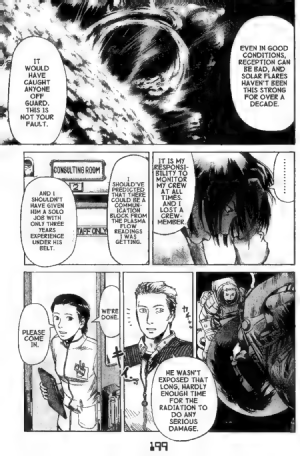 |
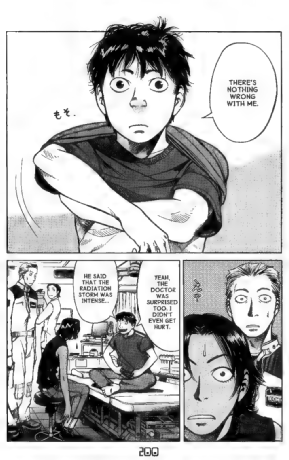 |
 |
While the threat is greatest in space, it is not insignificant even on the surface of planets. Many of the most accessible rocky bodies available for human exploration, including the Moon and Mars, lack a protective magnetosphere or thick atmosphere, and radiation exposure is a serious problem, with the chances of being affected by solar storms rising constantly with elapsed time. However the usual approach in both past and current science fiction is to set aside the problem of space weather exposure as one that will be solved in parallel with the many other innovations required. Indeed in older science fiction, protection from the hard radiation emission of astronauts’ own fission-powered spacecraft is usually a more pressing concern! In more recent science fiction, while some radiation shielding is typically shown, the scale of the problem is often consciously ignored.
Andy Weir, author of The Martian (novel 2011, film 2015) for example follows many other authors in simply assuming the problem of radiation exposure for his astronauts will be resolved in some manner between now and his work’s setting. In an address to scientists at the Lawrence Livermore National Laboratory he is recorded as saying:
"I just have a paragraph or two that say 'Oh yeah the Hab, the Rovers, the EVA suit, they're all radiation shielded.' In reality, that's a huge problem and there is no thin, easy, light material that completely takes care of it. So realistically having been through what he went through and being on Mars for so long, Mark would have so much cancer his cancer would have cancer. But it's a magical technology that they've developed between now and 2035."
The Threat to Technology
While direct radiation exposure is likely a severe problem only for the few able to travel beyond Earth’s atmosphere, space weather presents another risk factor which has the potential to severely affect the entire human population. In 1859, the strongest recorded solar storm – the Carrington Event – caused some telegraph lines to fail, and allowed others to operate without an attached power supply. In March 1989 another powerful solar storm caused a nine-hour failure of Quebec’s power supply, as well as knocking out radio communications and causing a loss of control of orbital satellites. Other storms of similar or greater power have led to ejections that have narrowly missed Earth’s position in orbit at the time.
With an increasing fraction of our technology reliant on robust power supplies, long-distance telecommunications, global positioning satellites and other earth-monitoring space utilisation, there is a very real threat of a solar storm on the scale of these earlier events causing catastrophic damage. Unsurprisingly, this premise has attracted the attention of science fiction.
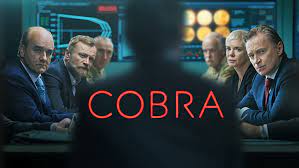 In 2020, the near-future drama series COBRA [2] considered the possible responses of the UK government to societal damage caused by a solar flare. This causes both the power grid and navigational resources to fail. Pitched as political drama rather than science fiction, this story nonetheless falls within the genre, presenting a rational extrapolation from current knowledge and projecting its effects. While this is drama, the UK government does indeed have both a Space Weather Preparedness Strategy and a Severe Space Weather Preparedness Strategy, as do other governments around the world. Our satellite-dependent technological society is certainly vulnerable, although perhaps unlikely to collapse as thoroughly and disasterously as some post-apocalyptic fiction (e.g. Scott B Williams’ The Pulse series) might suggest.
In 2020, the near-future drama series COBRA [2] considered the possible responses of the UK government to societal damage caused by a solar flare. This causes both the power grid and navigational resources to fail. Pitched as political drama rather than science fiction, this story nonetheless falls within the genre, presenting a rational extrapolation from current knowledge and projecting its effects. While this is drama, the UK government does indeed have both a Space Weather Preparedness Strategy and a Severe Space Weather Preparedness Strategy, as do other governments around the world. Our satellite-dependent technological society is certainly vulnerable, although perhaps unlikely to collapse as thoroughly and disasterously as some post-apocalyptic fiction (e.g. Scott B Williams’ The Pulse series) might suggest.
The vulnerability of human technology to space weather events will only grow if and when human space utilisation extends beyond Earth orbit. The animated television series Thunderbirds Are Go (2015-2018), for example, includes two different episodes (“Slingshot” and “Colony”) in which solar flares do not kill astronauts through radiation exposure, but nonetheless cause catastrophic failures of their space craft electronics and mechanisms. Since, in this future vision of space utilisation, all vehicles are heavily dependent on computer and AI control, such events cause severe difficulties and lead to a risk to life despite radiation shielding, plunging one vessel into the asteroid belt and throwing another towards the Sun.
Another children's science fiction narrative which features a spaceship whose technology fails in the face of a solar flare is Carole Wilkinson’s Out of Orbit (novel, 1999; aka Solar Flare) which is notable for taking place in the Alpha Centauri system. Here the characters are a small group living on a spaceship, and have a flare-survival routine for normal circumstances, including a shielded room in which children can avoid excessive exposure. Unfortunately a chance double flare from two stars at once overwhelms the ship and destroys their technology [3].
Indeed in rare cases, science fiction even shows alien technology as vulnerable to space weather – the eponymous stargate in Stargate: SG1 (TV series, 1997-2007), for example, has been known to make connections through time rather than space when passing through a solar flare, throwing the team traversing it back in time to 1969! Space weather with its associated stellar flares (both of our own sun and others, and occasionally even artificially triggered and weaponised) is also a recurrent threat in the Star Trek universe, Indeed such events appear in numerous episodes throughout the franchise’s history, dating as far back as 1968 when the strong flare of a dying sun forced the USS Enterprise out of orbit (ST:TOS “The Empath”) – as Mr Scott observes “That’ll play the very devil with the crew as well as the ship!”.
From an astronomical point of view, the frequent occurrences of solar flares and CMEs is not surprising - the vast majority of suns will show such events, albeit with varying degrees of severity. What is perhaps slightly more surprising is the number of highly unstable and frequently flaring stars in science fiction shown as hosting inhabited planets. Any such instability is likely to be rather an inhibiting factor in the development of advanced or intelligent life, and is unlikely to show a particularly sudden and unexpected onset.
The threat presented by space weather – to astronauts, to technologies in space and to the electronics we rely on here on Earth – has long been recognised in both science and science fiction. However the immediacy of the problem has only grown as global telecommunications have developed. At the same time, long term monitoring of the Sun and other stars have made it clear how lucky we have been to escape damage in the past, and how likely we are to face a space-weather induced crisis in the future. As the COBRA drama demonstrates, this has moved from a speculative problem affecting a few, or a possible distant future, to an issue of political and current-day relevance for everyone. As always, science fiction explores a range of possible space-weather scenarios and how humanity will deal with them. However it remains to be seen whether such speculative prototyping will be of any use in actually confronting this threat, or how it will be dealt with in any future realisation of space utilisation.
"The Weather from the Sun", Elizabeth Stanway. Cosmic Stories blog, 29th January 2023.
Notes:
[1] The Earth’s aurora borealis, or Northern Lights, are actually tapped for power in the Thunderbirds Are Go episode “Recharge” (TV animation, 2015) – an unlikely source of energy since the currents and charges involved are tiny despite their impressive display. [Return to text]
[2] The title references the informal name of the UK government’s emergency response committee which meets in Cabinet Office Briefing Room A. A second series of the drama series focuses on a tragic incident followed by chaos resulting from a cyber attack, continuing the theme of near-future political and human science fiction confronting plausible technological catastrophes. [Return to text]
[3] There is really rather a lot wrong about the science in this story (and the economics, politics, practicalities etc), and a lot of things which seem to happen for the sake of the narrative but don’t make an awful lot of sense. It’s an enjoyable enough kids survival-without-parents story, but with plenty of flaws. [Return to text]
All opinions and comments are the responsibility of the author and do not necessarily reflect the views of the University of Warwick. All images sources from public archives under fair use provisions for commentary and criticism.
